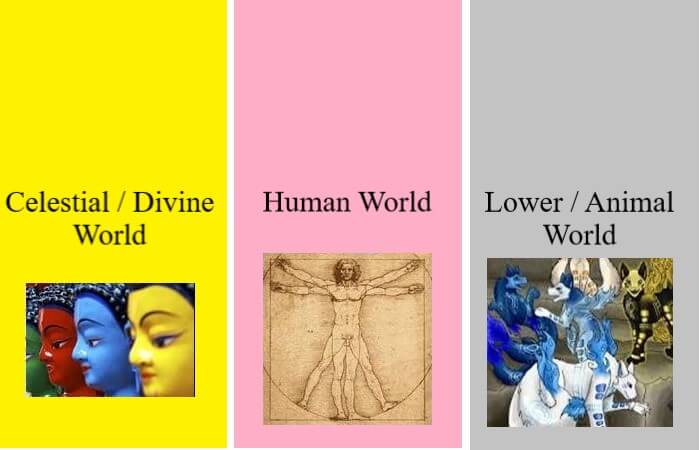Author: Randeep Singh / go to all Samkhya Karikas

Samkhya karika 53 text:
Ashtavikalpo daivastairyagyonashcha panchadhaa bhavati |
Maanushaka schaikavidhah samaasato bhautikah sargah ||
Ashtavikalpo – eight unique kinds
Daivas – divine
Tairyagyonas – through mediocre wombs
Cha – and
Panchadhaa – five fold
Bhavati – proceeds
Maanushaka – humans
cha – andClassification
Aikavidhah – of one kind
Samaasato – in short / brief
Bhautikah – physical, material world or matter, gross elements
Sargah – evolution
Samkhya Karika 53, for the first time talks about distinctions, level of sentient beings, along with the insentient material objects,that are created as a result of the evolutionary process of Prakriti. The various elements of ‘Bhautilak Sargah, or the material physical world as created by this evolutionary process can be distinguished into different levels.
The basis of this distinction has not been clarified in this Sankhya karika per se, details of which are given in the karikas forthcoming after this one. Here, one is very clear that the material elements which are being classified, or distinct are the ones which are sentient, or living beings as we humans recognise them.
Three Evolution Levels in Prakriti – Samkhya Karika 52
Samkhya karika 53 states that the sentient being which evolve from the evoltuionary process of Prakriti are of three types: Divine, or celestial beings with supernatural powers are of eight types, Beings which are considered lower than the divine beings are of five types, and Humans, are of a separate type which is of one kind only.
The makes the total types of being so created, as Prakriti evolves, as fourteen.
Since humans are being clearly categorised separately, one can assume that the lower types, as mentioned apart from the divine beings, are being referred to animals. Here, only the types and thier numbers is mentioned, the basis of these distinctions so made has not been elaborated upon.
Going by the nature of distinctions of the beings as mentioned one can assume the basis for the same could be the intellectual abilities, or evolution of the intellect in these beings. The divine beings are more evolved in their intellectual faculties or possess purer Buddhi in comparison to the other two types.
It may also mean that beings which have progressed higher on the path of spirituality come to possess higher abilities and powers (Siddhis) than the lower types and the humans. We can equate these divine or celestial being to Gods from the human perspective. Samkhya Philosophy does not believe in the existnce of God as a separate entity as envisioned by humans in general.
The author of Samkhya (Isvar Krisna) here seems to attribute the qualities of the beings who have significantly progressed on the path towards realising the Purusha or attaining liberation from their material existence to the celestial class or type mentioned here.
Though the celestial beings possess higher qualities, powers vis a vis the lower class and humans they are very much the part and parcel of the material. physical universe. These are not some supernatural beings which exist in some external realm which is not accessible to the other two class types.
The dimension the intellect (Buddhi) of these beings exists in decides thier type or class. For example, the celestial class or type possesses more Sattva guna dimensions than the other two.
Another important thing to note in this karika (Samkhya karika 53) is that humans are only of one kind. This can mean that humans are of a special class in relation to the other two types. We would be getting more clarity on this in further karikas.
